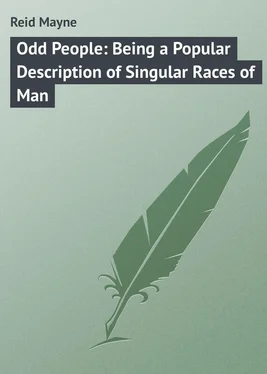Mayne Reid - Odd People - Being a Popular Description of Singular Races of Man
Здесь есть возможность читать онлайн «Mayne Reid - Odd People - Being a Popular Description of Singular Races of Man» — ознакомительный отрывок электронной книги совершенно бесплатно, а после прочтения отрывка купить полную версию. В некоторых случаях можно слушать аудио, скачать через торрент в формате fb2 и присутствует краткое содержание. Жанр: foreign_prose, на английском языке. Описание произведения, (предисловие) а так же отзывы посетителей доступны на портале библиотеки ЛибКат.
- Название:Odd People: Being a Popular Description of Singular Races of Man
- Автор:
- Жанр:
- Год:неизвестен
- ISBN:нет данных
- Рейтинг книги:4 / 5. Голосов: 1
-
Избранное:Добавить в избранное
- Отзывы:
-
Ваша оценка:
- 80
- 1
- 2
- 3
- 4
- 5
Odd People: Being a Popular Description of Singular Races of Man: краткое содержание, описание и аннотация
Предлагаем к чтению аннотацию, описание, краткое содержание или предисловие (зависит от того, что написал сам автор книги «Odd People: Being a Popular Description of Singular Races of Man»). Если вы не нашли необходимую информацию о книге — напишите в комментариях, мы постараемся отыскать её.
Odd People: Being a Popular Description of Singular Races of Man — читать онлайн ознакомительный отрывок
Ниже представлен текст книги, разбитый по страницам. Система сохранения места последней прочитанной страницы, позволяет с удобством читать онлайн бесплатно книгу «Odd People: Being a Popular Description of Singular Races of Man», без необходимости каждый раз заново искать на чём Вы остановились. Поставьте закладку, и сможете в любой момент перейти на страницу, на которой закончили чтение.
Интервал:
Закладка:
The Maracaibo Indian is not a stranger to commerce. He has been “Christianised,” – to use the phraseology of his priestly proselytiser, – and this has introduced him to new wants and necessities. Expenses that in his former pagan state were entirely unknown to him, have now become necessary, and a commercial effort is required to meet them. The Church must have its dues. Such luxuries as being baptised, married, and buried, are not to be had without expense, and the padre takes good care that none of these shall be had for nothing. He has taught his proselyte to believe that unless all these rites have been officially performed there is pot the slightest chance for him in the next world; and under the influence of this delusion, the simple savage willingly yields up his tenth, his fifth, or, perhaps it would be more correct to say, his all. Between fees of baptism and burial, mulcts for performance of the marriage rite, contributions towards the shows and ceremonies of dias de fiesta , extravagant prices for blessed beads, leaden crucifixes, and images of patron saints, the poor Christianised Indian is compelled to part with nearly the whole of his humble gains; and the fear of not being able to pay for Christian burial after death, is often one of the torments of his life.
To satisfy the numerous demands of the Church, therefore, he is forced into a little action in the commercial line. With the water-dweller of Maracaibo, fish forms one of the staples of export trade, – of course in the preserved state, as he is too distant from any great town or metropolis to be able to make market of them while fresh. He understands, however, the mode of curing them, – which he accomplishes by sun-drying and smoking, – and, thus prepared, they are taken off his hands by the trader, who carries them all over the West Indies, where, with boiled rice, they form the staple food of thousands of the dark-skinned children of Ethiopia.
The Maracaibo Indian, however, has still another resource, which occasionally supplies him with an article of commercial export. His country – that is, the adjacent shores of the lake – produces the finest caoutchouc . There the India-rubber tree, of more than one species, flourishes in abundance; and the true “seringa,” that yields the finest and most valuable kind of this gummy juice, is nowhere found in greater perfection than in the forests of Maracaibo. The caoutchouc of commerce is obtained from many other parts of America, as well as from other tropical countries; but as many of the bottles and shoes so well-known in the india-rubber shops, are manufactured by the Indians of Maracaibo, we may not find a more appropriate place to give an account of this singular production, and the mode by which it is prepared for the purposes of commerce and manufacture.
As already mentioned, many species of trees yield india-rubber, most of them belonging either to the order of the “Morads,” or Euphorbiaceae . Some are species of ficus , but both the genera and species are too numerous to be given here. That which supplies the “bottle india-rubber” is a euphorbiaceous plant, – the seringa above mentioned, – whose proper botanical appellation is Siphonia elastica . It is a tall, straight, smooth-barked tree, having a trunk of about a foot in diameter, though in favourable situations reaching to much larger dimensions. The process of extracting its sap – out of which the caoutchouc is manufactured – bears some resemblance to the tapping of sugar-maples in the forests of the north.
With his small hatchet, or tomahawk, the Indian cuts a gash in the bark, and inserts into it a little wedge of wood to keep the sides apart. Just under the gash, he fixes a small cup-shaped vessel of clay, the clay being still in a plastic state, so that it may be attached closely to the bark. Into this vessel the milk-like sap of the seringa soon commences to run, and keeps on until it has yielded about the fifth of a pint. This, however, is not the whole yield of a tree, but only of a single wound; and it is usual to open a great many gashes, or “taps,” upon the same trunk, each being furnished with its own cup or receiver. In from four to six hours the sap ceases to run.
The cups are then detached from the tree, and the contents of all, poured into a large earthen vessel, are carried to the place where the process of making the caoutchouc is to take place, – usually some dry open spot in the middle of the forest, where a temporary camp has been formed for the purpose.
When the dwelling of the Indian is at a distance from where the india-rubber tree grows, – as is the case with those of Lake Maracaibo, – it will not do to transport the sap thither. There must be no delay after the cups are filled, and the process of manufacture must proceed at once, or as soon as the milky juice begins to coagulate, – which it does almost on the instant.
Previous to reaching his camp, the “seringero” has provided a large quantity of palm-nuts, with which he intends to make a fire for smoking the caoutchouc. These nuts are the fruit of several kinds of palms, but the best are those afforded by two magnificent species, – the “Inaja” ( Maximiliana regia ), and the “Urucuri” ( Attalea excelsa ).
A fire is kindled of these nuts; and an earthen pot, with a hole in the bottom, is placed mouth downward over the pile. Through the aperture now rises a strong pungent smoke.
If it is a shoe that is intended to be made, a clay last is already prepared, with a stick standing out of the top of it, to serve as a handle, while the operation is going on. Taking the stick in his hand, the seringero dips the last lightly into the milk, or with a cup pours the fluid gently over it, so as to give a regular coating to the whole surface; and then, holding it over the smoke, he keeps turning it, jack-fashion, till the fluid has become dry and adhesive. Another dip is then given, and the smoking done as before; and this goes on, till forty or fifty different coats have brought the sides and soles of the shoe to a proper thickness. The soles, requiring greater weight, are, of course, oftener dipped than the “upper leather.”
The whole process of making the shoe does not occupy half an hour; but it has afterwards to receive some farther attention in the way of ornament; the lines and figures are yet to be executed, and this is done about two days after the smoking process. They are simply traced out with a piece of smooth wire, or oftener with the spine obtained from some tree, – as the thorny point of the bromelia leaf.
In about a week the shoes are ready to be taken from the last; and this is accomplished at the expense and utter ruin of the latter, which is broken into fragments, and then cleaned out. Water is used sometimes to soften the last, and the inner surface of the shoe is washed after the clay has been taken out.
Bottles are made precisely in the same manner, – a round ball, or other shaped mass of clay, serving as the mould for their construction. It requires a little more trouble to get the mould extracted from the narrow neck of the bottle.
It may be remarked that it is not the smoke of the palm-nuts that gives to the india-rubber its peculiar dark colour; that is the effect of age. When freshly manufactured, it is still of a whitish or cream colour; and only attains the dark hue after it has been kept for a considerable time.
We might add many other particulars about the mode in which the Indian of Maracaibo employs his time, but perhaps enough has been said to show that his existence is altogether an odd one.
Chapter Four.
The Esquimaux
The Esquimaux are emphatically an “odd people,” perhaps the oddest upon the earth. The peculiar character of the regions they inhabit has naturally initiated them into a system of habits and modes of life different from those of any other people on the face of the globe; and from the remoteness and inaccessibility of the countries in which they dwell, not only have they remained an unmixed people, but scarce any change has taken place in their customs and manners during the long period since they were first known to civilised nations.
Читать дальшеИнтервал:
Закладка:
Похожие книги на «Odd People: Being a Popular Description of Singular Races of Man»
Представляем Вашему вниманию похожие книги на «Odd People: Being a Popular Description of Singular Races of Man» списком для выбора. Мы отобрали схожую по названию и смыслу литературу в надежде предоставить читателям больше вариантов отыскать новые, интересные, ещё непрочитанные произведения.
Обсуждение, отзывы о книге «Odd People: Being a Popular Description of Singular Races of Man» и просто собственные мнения читателей. Оставьте ваши комментарии, напишите, что Вы думаете о произведении, его смысле или главных героях. Укажите что конкретно понравилось, а что нет, и почему Вы так считаете.












